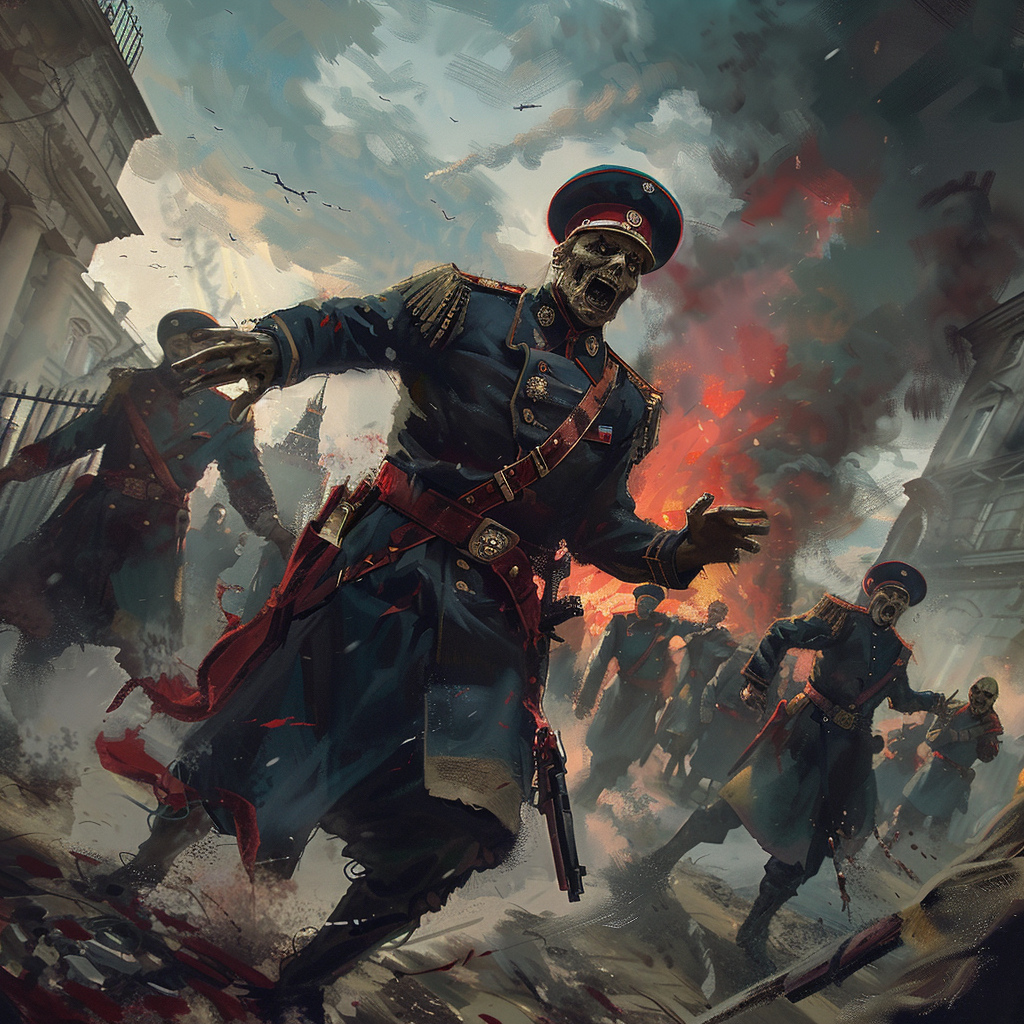
Roleplaying Game
Horror-Survival
Alternate History
From each according to their hunger, to each a fate worse than death.
In the smoldering ashes of the Russian Empire, where Marxist ideals clash with imperial nostalgia, a far greater spectre haunts Europe: the undead.
The Reds, fueled by revolutionary fervor, battle the Whites, who cling to their fading vision of monarchist order. But both factions are steadily losing ground to the Greys, unrelenting hordes of undead that care nothing for ideology or class struggle.
—
Better Red Than Undead is a tabletop roleplaying game set in an alternate 1920, where the Russian Civil War spirals into apocalyptic horror. This is a game of strategy, survival, and storytelling.
Players must navigate the chaos of war, the relentless march of the undead, and the moral dilemmas of a crumbling society. Whether you align with the revolutionary Reds, the embattled Whites, or forge your own path in the Pale Provinces, every decision matters, because victory belongs only to those who endure both the living and the dead.

Timeline
1917
March 15: Tsar Nicholas II abdicates, ending over 300 years of Romanov rule. The Provisional Government forms, but immediately competes with the Petrograd Soviet and local workers’ councils for power.
April 3: Vladimir Lenin returns to Petrograd, publishing the April Theses, calling for “peace, land, and bread” and urging the overthrow of the tsarist government.
July 16-17: The July Days protests are violently suppressed. Lenin flees Petrograd; several Bolshevik leaders are arrested.
November 7: The October Revolution begins. The Bolsheviks seize control of Petrograd, storm the Winter Palace, and overthrow the Provisional Government. The Russian Soviet Federative Socialist Republic (RSFSR) is proclaimed.
Map of new borders established by the Treaty of Brest-Litovsk.
1919
February: Admiral Alexander Kolchak, now titled Supreme Ruler of the Russian State, leads White offensives east of the Urals. Retreating soldiers report “enemy dead still moving.”
April 14: A Red Army patrol near Kazan report being overrun by shambling hordes of infected civilians. Survivors are quarantined. High command dismisses the report as hysteria.
August: An outbreak strikes Krasnoyarsk. Victims exhibit symptoms resembling rabies: uncontrollable violence, glazed pupils, and fevered muttering before death. Medics are forbidden to publish findings.
October: Infection spreads westward. Cases appear in Smolensk and Bryansk, but are dismissed as “sabotage and counter-revolutionary propaganda.”
November 1: In Central Asia, Amir Davud Mirza, a former White Army officer, defects and begins organizing guerrilla forces under the Southern Provisional Council of Khorasan.
December: Red command initiates covert containment protocols and burns multiple affected towns in the Urals. Internal memos acknowledge “non-natural pathology.” Rumors circulate that the Whites have weaponized the infection.
Finnish soldiers push back the Red Army in a surprise offensive to take the Karelian Isthmus.
Vladimir Lenin addressing the Second All-Russian Congress of Soviets in Petrograd.
1918
January 5: The Constituent Assembly is dissolved by the Bolsheviks after a single session, consolidating single-party control.
March 3: Russia signs the Treaty of Brest-Litovsk with Germany, ending its involvement in the Great War and ceding vast western territories.
June: The Red Army is formally established under Leon Trotsky, tasked with defending the revolution.
July 17: The former tsar and his family are executed in Yekaterinburg by Bolshevik forces.
August: First whispers of strange illnesses emerge in remote Ural villages. Local describe bodies refusing to decay and erratic aggression. Official reports label these “rural superstition.”
September: Amid Russian instability, Finland formally declares independence, forming the groundwork for the Greater Finland movement.
October-November: As Red-White skirmishes erupt across the Volga and Don, disappearances of entire units are reported in Siberia. Officially labeled as desertions or logistical failures.
Admiral Kolchak retreats further eastward with his men after defeat at Krasnoyarsk.
1920
January: Carl Gustaf Emil Mannerheim, Commander of the Finnish White Guard, orders an advance across the Karelian Isthmus, threatening Petrograd’s northern rail supply. Meanwhile, Khorasan insurgents, led by Davud Mirza, launch coordinated ambushes near Ashgabat and Bukhara, disrupting White control of the region.
February 24: Nestor Makhno and his Black Army expel Red garrisons from Crimea, establishing fortified anarchist communes from Simferopol to Sevastopol. Red attempts to reclaim the peninsula falter amidst both fierce resistance and growing undead presence along the southern coast.
March 6: A ceasefire is signed between Greater Finland and the Bolsheviks, halting direct hostilities along the Karelian front. Both sides quietly entrench. Red leadership, nominally under Lenin, begins issuing denials of any widespread outbreak, even as commissars quietly execute suspected infected along the western front.
Mid-March: In the Russian Far East, General Otani Kikuzo of the Imperial Japanese Army solidifies control of Vladivostok, Sakhalin, and territory south of the Amur River. Railway lines are reinforced, quarantine protocols expand, and military labs in Harbin and Sakhalin begin autopsies on infected cadavers.
April: An early spring thaw triggers widespread undead resurgence across the central wilderness. The Blednaya Oblast (“Pale Province”), an undead-infested region between the Yenisey and Lena Rivers, becomes impassable. White strongholds go silent. Anarchist communiques from Crimea claim to have “found a way to live with the infected.” No verification follows. Japanese engineers fortify remaining rail corridors and key stations to prevent spread into occupied zones.













